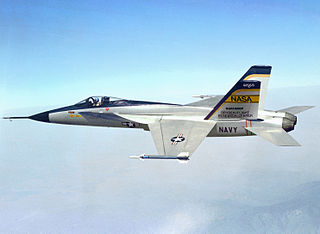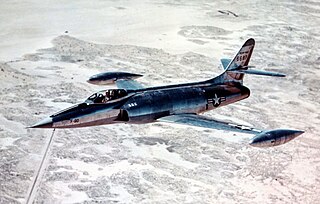
The McDonnell XF-88 Voodoo was a long-range, twinjet fighter aircraft with swept wings designed for the United States Air Force. Although it never entered production, its design was adapted for the subsequent supersonic F-101 Voodoo.

The Bell XP-83 was a United States prototype jet escort fighter designed by Bell Aircraft during World War II. It first flew in 1945. As with most early first generation jet fighters, the design was hampered by a relative lack of power. With the rapid advancements in jet technology post-WWII, the XP-83 was soon eclipsed by more advanced designs and it never entered production.

The Northrop YF-17 is a prototype lightweight fighter aircraft designed by Northrop aviation for the United States Air Force's Lightweight Fighter (LWF) technology evaluation program. The LWF was initiated because many in the fighter community believed that aircraft like the F-15 Eagle were too large and expensive for many combat roles. The YF-17 was the culmination of a long line of Northrop designs, beginning with the N-102 Fang in 1956, continuing through the F-5 family.

The Rutan VariEze is a composite, canard aircraft designed by Burt Rutan. It is a high-performance homebuilt aircraft, hundreds of which have been constructed. The design later evolved into the Long-EZ and other, larger cabin canard aircraft. The VariEze is notable for popularizing the canard configuration and moldless glass cloth composite construction for homebuilt aircraft.

The Aermacchi AL-60 is a light civil utility aircraft of the late 1950s and early 1960s, originally designed by Al Mooney of Lockheed in the United States. After the company decided not to build the aircraft in the US, it was manufactured in small quantities in Mexico, and a few were assembled in Argentina by Aviones Lockheed-Kaiser Argentina. It was also built in quantity under licence by Aermacchi in Italy and Atlas Aircraft Corporation in South Africa.

The Lockheed XF-90 was built in response to a United States Air Force requirement for a long-range penetration fighter and bomber escort. The same requirement produced the McDonnell XF-88 Voodoo. Lockheed received a contract for two prototype XP-90s. The design was developed by Willis Hawkins and the Skunk Works team under Kelly Johnson. Two prototypes were built. Developmental and political difficulties delayed the first flight until 3 June 1949, with Chief Test Pilot Tony LeVier at the controls. Embodying the experience gained in developing the P-80 Shooting Star, the XF-90 shared some design traits with the older Lockheed fighter, albeit with swept-wings; however, this latter design choice could not sufficiently make up for the project’s underpowered engines, and the XF-90 never entered production.

The North American YF-93 was an American fighter development of the F-86 Sabre that emerged as a radically different variant that received its own designation. Two were built and flown before the project was eventually canceled.

The Lockheed XF-104 Starfighter was a single-engine, high-performance, supersonic interceptor prototype for a United States Air Force (USAF) series of lightweight and simple fighters. Only two aircraft were built; one aircraft was used primarily for aerodynamic research and the other served as an armament testbed, both aircraft being destroyed in accidents during testing. The XF-104s were forerunners of over 2,500 production Lockheed F-104 Starfighters.
The DSK Airmotive DSK-1 Hawk was an unusual homebuilt aircraft designed in the United States in the early 1970s. While the design itself was utterly conventional - a single-seat low-wing cantilever monoplane with fixed tricycle undercarriage - its method of construction was not, since the DSK-1 Hawk used a surplus 200 US Gal military drop tank as its fuselage. Designer Richard Killingsworth sold over 250 sets of plans.
The Viper Aircraft ViperJet is a small homebuilt jet aircraft by Viper Aircraft Corporation. It is a conventional, low-wing monoplane with swept wings and tail and two seats in tandem under a bubble canopy. The jet intakes are located at the sides of the fuselage and the tricycle undercarriage is retractable. Construction throughout is of composite materials.

The W.A.R. FW-190 is a half-scale homebuilt replica of a Focke-Wulf Fw 190 fighter. In July 1973, War Aircraft Replicas International of Santa Paula, California began design of an approximately half-scale replica of the Fw 190, the first of a series of replicas of World War II aircraft using similar constructional techniques. The first prototype made its maiden flight on 21 August 1974.

The Aeronix Airelle is a tandem wing ultralight with twin engines in push-pull configuration, that was designed and built in France at the start of the millennium. It was intended to be homebuilt from kits, and a few prototypes were constructed, but development ended when the company went into receivership in 2006.
The TeST TST-14J BonusJet is a two-seat touring motor glider with a retractable PBS TJ-100 turbine engine, built by TeST in the Czech Republic. It is an all composite design.

The Ameur Altania was a single-engine light aircraft of pusher configuration with side-by-side seats for two and a V-tail, designed in France in the 1990s. Several prototypes were built and flown, including a 15 m span motorglider version; the final prototype was constructed from carbon composites rather than glass fibre. Another version, the UCA Carbon Bird has been built by Universal Composite Aviation after the bankruptcy of Ameur Aviation.
The O'Neill Model J Magnum, also called the Magnum Jake and the Magnum Pickup, is a homebuilt aircraft design for bush flying operations similar to the de Havilland Beaver.

The Velocity V-Twin is an American twin engined, homebuilt aircraft, designed by Velocity Aircraft and following the layout of their earlier Velocity XL but with a single vertical tail. It is the flagship model of the Velocity Aircraft Line.

The Microleve Corsario is a Brazilian amphibious ultralight flying boat that was designed and produced by Microleve of Rio de Janeiro. The aircraft was supplied as a kit for amateur construction.

The Peak Aerospace Me 109R is a family of German replica warbird ultralight aircraft that was designed by Tassilo Bek, and originally produced by Peak Aerospace of Pasewalk. The company since changed its name to Classic Planes GmbH. The design, first flown in 1991, is an 80% scale replica of the Second World War Messerschmitt Bf 109 and is supplied as a kit for amateur construction or as a complete ready-to-fly-aircraft.
The Weinberg S.E.5a Replica is an American homebuilt biplane that was designed by William Weinberg of Kansas City, Missouri. The aircraft was supplied in the form of plans for amateur construction, but the plans seem to no longer be available.
The Stargate YT-33 is an American homebuilt aircraft that was designed and intended to be produced by Stargate, Inc of McMinnville, Oregon, introduced in 1994. The aircraft is a 2/3 scale replica of the Lockheed T-33 jet trainer.














